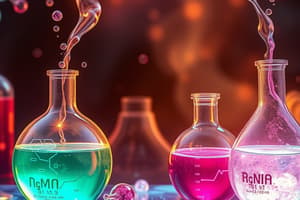Podcast
Questions and Answers
What name is given to the process seen in this animation?
What name is given to the process seen in this animation?
dehydration synthesis
Which of the following parts of an amino acid vary among different amino acids?
Which of the following parts of an amino acid vary among different amino acids?
the side chain, or R group
Which class(es) of amino acids possess side chains that would be unable to form hydrogen bonds with water?
Which class(es) of amino acids possess side chains that would be unable to form hydrogen bonds with water?
amino acids with nonpolar side chains
In which figure are the N-terminus, C-terminus, Amino Group, and Carboxyl Group correctly labeled?
In which figure are the N-terminus, C-terminus, Amino Group, and Carboxyl Group correctly labeled?
What type of bond joins the monomers in a protein's primary structure?
What type of bond joins the monomers in a protein's primary structure?
Proteins are polymers of _____
Proteins are polymers of _____
Which of these illustrates the secondary structure of a protein?
Which of these illustrates the secondary structure of a protein?
The secondary structure of a protein results from _____
The secondary structure of a protein results from _____
Tertiary structure is NOT directly dependent on _____
Tertiary structure is NOT directly dependent on _____
_____ structure is achieved when a protein folds into a compact, three-dimensional shape stabilized by interactions between side-chain R groups of amino acids.
_____ structure is achieved when a protein folds into a compact, three-dimensional shape stabilized by interactions between side-chain R groups of amino acids.
_____ structure describes the alpha-helices and beta-sheets formed by hydrogen bonding between backbone atoms.
_____ structure describes the alpha-helices and beta-sheets formed by hydrogen bonding between backbone atoms.
_____ structure is the sequence of amino acids in a protein.
_____ structure is the sequence of amino acids in a protein.
_____ structure is the result of two or more protein subunits assembling to form a larger, biologically active protein complex.
_____ structure is the result of two or more protein subunits assembling to form a larger, biologically active protein complex.
What is unique about the tertiary and quaternary structures of proteins?
What is unique about the tertiary and quaternary structures of proteins?
How many different primary sequences can be generated by randomly assembling amino acids into peptides that are five residues long?
How many different primary sequences can be generated by randomly assembling amino acids into peptides that are five residues long?
What is a major limitation of the ribbon model of a protein?
What is a major limitation of the ribbon model of a protein?
Which statement best explains the difference in R-groups based on electronegativities?
Which statement best explains the difference in R-groups based on electronegativities?
Some proteins can fold spontaneously.
Some proteins can fold spontaneously.
Where is the information that directs different polypeptides to fold into different shapes?
Where is the information that directs different polypeptides to fold into different shapes?
What is an active site?
What is an active site?
Why are proteins not considered to be a good candidate for the first living molecule?
Why are proteins not considered to be a good candidate for the first living molecule?
Which types of amino acids would you predict to be present in the DNA binding sites of proteins?
Which types of amino acids would you predict to be present in the DNA binding sites of proteins?
In a polypeptide, what bonds are responsible for the primary structure?
In a polypeptide, what bonds are responsible for the primary structure?
What features of protein folding and function are revealed by calmodulin and prions?
What features of protein folding and function are revealed by calmodulin and prions?
Nonpolar amino acid residues are typically found in the interior of globular proteins like trypsin. What chemical force is most directly responsible?
Nonpolar amino acid residues are typically found in the interior of globular proteins like trypsin. What chemical force is most directly responsible?
Proteins are polymers of _____
Proteins are polymers of _____
Study Notes
Dehydration Synthesis
- Dehydration synthesis is the process where monomers are linked together by removing water.
Amino Acids
- Amino acids consist of an amino group, carboxyl group, hydrogen, and a unique side chain (R group).
- The R group varies among the 20 different amino acids, determining their unique properties.
Nonpolar Amino Acids
- Amino acids with nonpolar side chains are hydrophobic and cannot form hydrogen bonds with water.
Tripeptide Structure
- Tripeptides consist of three amino acids linked together, with specific ends labeled as N-terminus and C-terminus.
Primary Structure Bonds
- The primary structure of a protein is formed by peptide bonds linking the amino acid monomers.
Protein Polymers
- Proteins are classified as polymers made up of amino acids.
Secondary Protein Structure
- Secondary structures include alpha helices and beta pleated sheets, stabilized by hydrogen bonds.
Hydrogen Bonds
- Hydrogen bonds play a crucial role in maintaining secondary structure by interacting with electronegative oxygen and nitrogen atoms.
Tertiary Structure
- The tertiary structure of a protein is achieved as it folds into a compact three-dimensional shape, stabilized by interactions among R groups, and is not directly dependent on peptide bonds.
Quaternary Structure
- Quaternary structure occurs when multiple protein subunits assemble to create larger, biologically active complexes.
Primary Sequence Variability
- Up to 3,200,000 different primary sequences can result from random combinations of the 20 amino acids in a peptide five residues long.
Ribbon Model Limitation
- The ribbon model may misrepresent the spatial arrangement within proteins, offering a false sense of open space as opposed to a more accurate space-filling model.
R-groups and Electronegativity
- Nonpolar R-groups (green) contain mainly carbon and hydrogen, while polar R-groups (pink) often include highly electronegative oxygen, indicating different chemical properties.
Spontaneous Folding
- Some proteins can fold spontaneously into their functional shapes, as demonstrated by ribonuclease studies in the 1950s.
Information in Primary Structure
- The sequence of amino acids in the primary structure contains the information necessary for proper protein folding.
Active Site Definition
- The active site of an enzyme is the specific region where substrates bind, facilitating enzymatic reactions.
Proteins as Candidates for Early Life
- Proteins are not ideal candidates for the first living molecule due to their inability to serve as templates for replication.
Basic Amino Acids and DNA Binding
- Basic amino acids are typically found in the DNA binding sites of proteins due to their positive charge interacting with the negatively charged DNA.
Bonds in Primary Structure
- Peptide bonds in a polypeptide are responsible for the maintenance of the primary structure.
Protein Folding and Function
- Proteins like calmodulin and prions showcase the diversity of protein shapes and emphasize that different conformations can affect functionality.
Hydrophobic Interactions
- Nonpolar amino acid residues are generally found within the interior of globular proteins, influenced by hydrophobic interactions that drive protein folding.
Studying That Suits You
Use AI to generate personalized quizzes and flashcards to suit your learning preferences.
Description
Test your knowledge of proteins with these flashcards from Chapter 3. Review the process of dehydration synthesis and the variations among amino acids. Perfect for students looking to solidify their understanding of protein structure and function.



